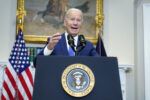Fed’s Powell: US inflation to fall further below 2% target
Federal Reserve Board Chairman Jerome Powell was upbeat about the US economic outlook, but sees inflation falling even further (ALEX WONG)
Washington (AFP) – Despite solid growth and continuing job gains, the US economy will see inflation fall even further below the central bank’s two percent goal, at least for a time, Federal Reserve Chairman Jerome Powell said Tuesday.
That forecast added weight to Powell’s repetition that the Fed will be “patient” before making any further changes in the benchmark borrowing rate.
“Recent declines in energy prices will likely push headline inflation further below the… longer-run goal of 2 percent for a time,” he said in semi-annual testimony before the US Senate Banking Committee.
The US central bank increased the key policy interest rate four times last year, but rising uncertainty, especially around the US trade confrontation with China, amplified concerns about slowing global growth and fears the Fed was moving too aggressively.
That prompted the Fed to signal clearly for the past several weeks that it would tread carefully and many economists now do not expect any increase this year, while a few say the next move could be a cut if the economy slows further.
Noting the Fed’s preferred annual inflation measure sits at 1.7 percent, Powell said “the extent and timing of any further rate increases would depend on incoming data and the evolving outlook.”
He remained upbeat about the economic outlook, saying Fed officials “generally expected economic activity to expand at a solid pace, albeit somewhat slower than in 2018, and the job market to remain strong.”
However, he acknowledged that “over the past few months we have seen some crosscurrents and conflicting signals,” including slower growth in major economies, especially China and Europe.
– ‘Unresolved’ issues –
“And uncertainty is elevated around several unresolved government policy issues, including Brexit and ongoing trade negotiations,” he cautioned. “We will carefully monitor these issues as they evolve.”
The United States and China have hammered each other with punitive tariffs on more than $360 billion in two-way trade, raising prices to producers and consumers and undercutting economic growth.
The International Monetary Fund cites the trade war between the world’s two largest economies as a “major risk” to global growth, and cut their growth forecast for this year.
But President Donald Trump on Monday said he expected to hold a “signing summit” soon with China’s leader Xi Jinping to resolve the issue and he pushed back the March 1 deadline which would have triggered tariffs to more than double on $200 billion in Chinese exports.
In the US economy, low inflation and sluggish wage growth — despite net job gains that averaged 223,000 last year and GDP gaining just under three percent — has continued to baffle economists and the Fed.
Powell noted some signs of stronger wage growth, particularly in lower-skilled jobs, but also said to “disparities persist” in the labor market along racial and ethnic lines, and also between rural and urban workers.
Longer-run trends, “such as relatively stagnant incomes for many families and a lack of upward economic mobility among people with lower incomes, also remain important challenges,” he said.
And he once again noted that “federal government debt is on an unsustainable path.”
US government debt has reached a record $22 trillion.
Disclaimer: This story is published from a syndicated feed. Siliconeer does not assume any liability for the above story. Validity of the above story is for 7 Days from original date of publishing. Content copyright AFP.

